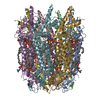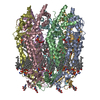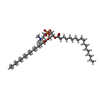[English] 日本語
 Yorodumi
Yorodumi- PDB-7f8n: Human pannexin-1 showing a conformational change in the N-termina... -
+ Open data
Open data
- Basic information
Basic information
| Entry | Database: PDB / ID: 7f8n | ||||||
|---|---|---|---|---|---|---|---|
| Title | Human pannexin-1 showing a conformational change in the N-terminal domain and blocked pore | ||||||
 Components Components | Pannexin-1 | ||||||
 Keywords Keywords |  TRANSPORT PROTEIN / ATP release channel / vertebrate innexin homolog TRANSPORT PROTEIN / ATP release channel / vertebrate innexin homolog | ||||||
| Function / homology |  Function and homology information Function and homology informationElectric Transmission Across Gap Junctions /  leak channel activity / positive regulation of interleukin-1 alpha production / bleb / wide pore channel activity / gap junction channel activity / leak channel activity / positive regulation of interleukin-1 alpha production / bleb / wide pore channel activity / gap junction channel activity /  gap junction / positive regulation of macrophage cytokine production / gap junction / positive regulation of macrophage cytokine production /  oogenesis / response to ATP ...Electric Transmission Across Gap Junctions / oogenesis / response to ATP ...Electric Transmission Across Gap Junctions /  leak channel activity / positive regulation of interleukin-1 alpha production / bleb / wide pore channel activity / gap junction channel activity / leak channel activity / positive regulation of interleukin-1 alpha production / bleb / wide pore channel activity / gap junction channel activity /  gap junction / positive regulation of macrophage cytokine production / gap junction / positive regulation of macrophage cytokine production /  oogenesis / response to ATP / monoatomic cation transport / The NLRP3 inflammasome / positive regulation of interleukin-1 beta production / response to ischemia / oogenesis / response to ATP / monoatomic cation transport / The NLRP3 inflammasome / positive regulation of interleukin-1 beta production / response to ischemia /  calcium channel activity / calcium ion transport / calcium channel activity / calcium ion transport /  actin filament binding / cell-cell signaling / actin filament binding / cell-cell signaling /  scaffold protein binding / scaffold protein binding /  protease binding / transmembrane transporter binding / protease binding / transmembrane transporter binding /  signaling receptor binding / endoplasmic reticulum membrane / structural molecule activity / signaling receptor binding / endoplasmic reticulum membrane / structural molecule activity /  endoplasmic reticulum / protein-containing complex / endoplasmic reticulum / protein-containing complex /  membrane / identical protein binding / membrane / identical protein binding /  plasma membrane plasma membraneSimilarity search - Function | ||||||
| Biological species |   Homo sapiens (human) Homo sapiens (human) | ||||||
| Method |  ELECTRON MICROSCOPY / ELECTRON MICROSCOPY /  single particle reconstruction / single particle reconstruction /  cryo EM / Resolution: 3.4 Å cryo EM / Resolution: 3.4 Å | ||||||
 Authors Authors | Kuzuya, M. / Hirano, H. / Hayashida, K. / Watanabe, M. / Kobayashi, K. / Tani, K. / Fujiyoshi, Y. / Oshima, A. | ||||||
 Citation Citation |  Journal: Sci Signal / Year: 2022 Journal: Sci Signal / Year: 2022Title: Structures of human pannexin-1 in nanodiscs reveal gating mediated by dynamic movement of the N terminus and phospholipids. Authors: Maki Kuzuya / Hidemi Hirano / Kenichi Hayashida / Masakatsu Watanabe / Kazumi Kobayashi / Tohru Terada / Md Iqbal Mahmood / Florence Tama / Kazutoshi Tani / Yoshinori Fujiyoshi / Atsunori Oshima /  Abstract: Pannexin (PANX) family proteins form large-pore channels that mediate purinergic signaling. We analyzed the cryo-EM structures of human PANX1 in lipid nanodiscs to elucidate the gating mechanism and ...Pannexin (PANX) family proteins form large-pore channels that mediate purinergic signaling. We analyzed the cryo-EM structures of human PANX1 in lipid nanodiscs to elucidate the gating mechanism and its regulation by the amino terminus in phospholipids. The wild-type channel has an amino-terminal funnel in the pore, but in the presence of the inhibitor probenecid, a cytoplasmically oriented amino terminus and phospholipids obstruct the pore. Functional analysis using whole-cell patch-clamp and oocyte voltage clamp showed that PANX1 lacking the amino terminus did not open and had a dominant negative effect on channel activity, thus confirming that the amino-terminal domain played an essential role in channel opening. These observations suggest that dynamic conformational changes in the amino terminus of human PANX1 are associated with lipid movement in and out of the pore. Moreover, the data provide insight into the gating mechanism of PANX1 and, more broadly, other large-pore channels. | ||||||
| History |
|
- Structure visualization
Structure visualization
| Movie |
 Movie viewer Movie viewer |
|---|---|
| Structure viewer | Molecule:  Molmil Molmil Jmol/JSmol Jmol/JSmol |
- Downloads & links
Downloads & links
- Download
Download
| PDBx/mmCIF format |  7f8n.cif.gz 7f8n.cif.gz | 413.9 KB | Display |  PDBx/mmCIF format PDBx/mmCIF format |
|---|---|---|---|---|
| PDB format |  pdb7f8n.ent.gz pdb7f8n.ent.gz | 346.8 KB | Display |  PDB format PDB format |
| PDBx/mmJSON format |  7f8n.json.gz 7f8n.json.gz | Tree view |  PDBx/mmJSON format PDBx/mmJSON format | |
| Others |  Other downloads Other downloads |
-Validation report
| Arichive directory |  https://data.pdbj.org/pub/pdb/validation_reports/f8/7f8n https://data.pdbj.org/pub/pdb/validation_reports/f8/7f8n ftp://data.pdbj.org/pub/pdb/validation_reports/f8/7f8n ftp://data.pdbj.org/pub/pdb/validation_reports/f8/7f8n | HTTPS FTP |
|---|
-Related structure data
| Related structure data |  31490MC  7f8jC  7f8oC  7wsvC M: map data used to model this data C: citing same article ( |
|---|---|
| Similar structure data | |
| EM raw data |  EMPIAR-10758 (Title: Structure of human pannexin-1 with a blocked pore / Data size: 459.1 EMPIAR-10758 (Title: Structure of human pannexin-1 with a blocked pore / Data size: 459.1 Data #1: human PANX1 in a blocked state [micrographs - multiframe]) |
- Links
Links
- Assembly
Assembly
| Deposited unit | 
|
|---|---|
| 1 |
|
- Components
Components
| #1: Protein |  Mass: 48093.863 Da / Num. of mol.: 7 Source method: isolated from a genetically manipulated source Source: (gene. exp.)   Homo sapiens (human) / Gene: PANX1, MRS1, UNQ2529/PRO6028 / Production host: Homo sapiens (human) / Gene: PANX1, MRS1, UNQ2529/PRO6028 / Production host:   Homo sapiens (human) / References: UniProt: Q96RD7 Homo sapiens (human) / References: UniProt: Q96RD7#2: Chemical | ChemComp-LBN /  POPC POPCHas ligand of interest | N | |
|---|
-Experimental details
-Experiment
| Experiment | Method:  ELECTRON MICROSCOPY ELECTRON MICROSCOPY |
|---|---|
| EM experiment | Aggregation state: PARTICLE / 3D reconstruction method:  single particle reconstruction single particle reconstruction |
- Sample preparation
Sample preparation
| Component | Name: human pannexin-1 / Type: COMPLEX / Entity ID: #1 / Source: RECOMBINANT / Type: COMPLEX / Entity ID: #1 / Source: RECOMBINANT | |||||||||||||||
|---|---|---|---|---|---|---|---|---|---|---|---|---|---|---|---|---|
| Molecular weight | Experimental value: NO | |||||||||||||||
| Source (natural) | Organism:   Homo sapiens (human) Homo sapiens (human) | |||||||||||||||
| Source (recombinant) | Organism:   Homo sapiens (human) Homo sapiens (human) | |||||||||||||||
| Buffer solution | pH: 7.5 | |||||||||||||||
| Buffer component |
| |||||||||||||||
| Specimen | Conc.: 3 mg/ml / Embedding applied: NO / Shadowing applied: NO / Staining applied : NO / Vitrification applied : NO / Vitrification applied : YES : YES | |||||||||||||||
| Specimen support | Grid material: MOLYBDENUM / Grid mesh size: 200 divisions/in. / Grid type: Quantifoil R2/2 | |||||||||||||||
Vitrification | Instrument: LEICA KF80 / Cryogen name: ETHANE |
- Electron microscopy imaging
Electron microscopy imaging
| Microscopy | Model: JEOL CRYO ARM 300 |
|---|---|
| Electron gun | Electron source : :  FIELD EMISSION GUN / Accelerating voltage: 300 kV / Illumination mode: FLOOD BEAM FIELD EMISSION GUN / Accelerating voltage: 300 kV / Illumination mode: FLOOD BEAM |
| Electron lens | Mode: BRIGHT FIELD Bright-field microscopy / Calibrated defocus min: 500 nm / Calibrated defocus max: 5000 nm / Cs Bright-field microscopy / Calibrated defocus min: 500 nm / Calibrated defocus max: 5000 nm / Cs : 2.7 mm : 2.7 mm |
| Specimen holder | Cryogen: NITROGEN / Specimen holder model: JEOL |
| Image recording | Average exposure time: 2.4 sec. / Electron dose: 40 e/Å2 / Film or detector model: GATAN K3 (6k x 4k) / Num. of real images: 1083 |
| EM imaging optics | Energyfilter name : In-column Omega Filter / Energyfilter slit width: 30 eV : In-column Omega Filter / Energyfilter slit width: 30 eV |
| Image scans | Width: 5760 / Height: 4092 |
- Processing
Processing
| Software | Name: PHENIX / Version: 1.19.2_4158: / Classification: refinement | ||||||||||||||||||||||||
|---|---|---|---|---|---|---|---|---|---|---|---|---|---|---|---|---|---|---|---|---|---|---|---|---|---|
| EM software |
| ||||||||||||||||||||||||
CTF correction | Type: PHASE FLIPPING ONLY | ||||||||||||||||||||||||
| Particle selection | Num. of particles selected: 422244 | ||||||||||||||||||||||||
| Symmetry | Point symmetry : C7 (7 fold cyclic : C7 (7 fold cyclic ) ) | ||||||||||||||||||||||||
3D reconstruction | Resolution: 3.4 Å / Resolution method: FSC 0.143 CUT-OFF / Num. of particles: 19897 / Symmetry type: POINT | ||||||||||||||||||||||||
| Refinement | Cross valid method: NONE Stereochemistry target values: GeoStd + Monomer Library + CDL v1.2 | ||||||||||||||||||||||||
| Displacement parameters | Biso mean: 34.65 Å2 | ||||||||||||||||||||||||
| Refine LS restraints |
|
 Movie
Movie Controller
Controller












 PDBj
PDBj








